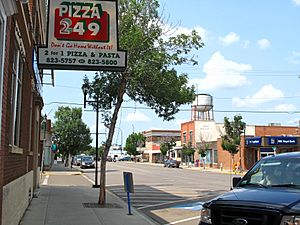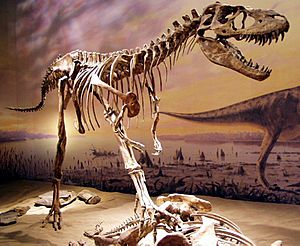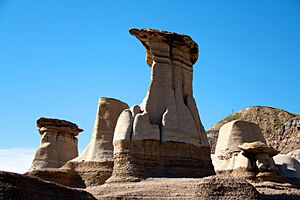Drumheller facts for kids
Quick facts for kids
Drumheller
|
||
|---|---|---|
|
Town
|
||
| Town of Drumheller | ||

Downtown Drumheller
|
||
|
||
| Nickname(s):
Dinosaur Capital of the World
|
||

Location within Alberta
|
||
| Country | Canada | |
| Province | Alberta | |
| Region | Southern Alberta | |
| Census division | 5 | |
| Adjacent municipal districts | Kneehill County, Starland County and Wheatland County | |
| Adjacent special area | Special Area No. 2 | |
| Founded | 1911 | |
| Incorporated | ||
| • Village | May 15, 1913 | |
| • Town | March 2, 1916 | |
| • City | April 3, 1930 | |
| • Town | January 1, 1998 | |
| Amalgamated | January 1, 1998 | |
| Area
(2021)
|
||
| • Land | 107.56 km2 (41.53 sq mi) | |
| Elevation | 670 m (2,200 ft) | |
| Population
(2021)
|
||
| • Total | 7,909 | |
| • Density | 73.5/km2 (190/sq mi) | |
| Time zone | UTC−7 (MST) | |
| • Summer (DST) | UTC−6 (MDT) | |
| Forward sortation area |
T0J
|
|
| Area code(s) | +1-403, +1-587 | |
Drumheller is a town in Alberta, Canada. It's located in the unique badlands area along the Red Deer River. Many people call it the "Dinosaur Capital of the World." It's about 110 kilometers (68 miles) northeast of Calgary. The river valley here, known as Dinosaur Valley, is about 2 kilometers (1.2 miles) wide and 28 kilometers (17 miles) long.
Contents
A Brief History of Drumheller
Drumheller was named after Samuel Drumheller. He bought land here and started selling lots for homes in 1911. That same year, he also began coal mining operations nearby.
The town got its own railway station in 1912. It officially became a village on May 15, 1913. Later, it became a town on March 2, 1916, and then a city on April 3, 1930. Drumheller grew very quickly during this time. Its population jumped from 312 people in 1916 to 2,987 in 1931.
Drumheller was a busy place until the end of Second World War. After the war, coal became less valuable, and the town's growth slowed down.
How Drumheller Became a Big Town
On January 1, 1998, the City of Drumheller joined with a nearby area called the Municipal District of Badlands No. 7. They formed the current Town of Drumheller. They decided to become a "town" instead of a "city." This meant the province of Alberta would still be in charge of the highways. Because of this merger, Drumheller became Alberta's largest town by land area. It covers about 107.93 square kilometers (41.67 square miles).
When Drumheller merged, it took in six smaller communities. These included Cambria, East Coulee, Lehigh, Nacmine, Rosedale, and Wayne. Before this, Drumheller had also added other areas like Bankview and Midlandvale. In total, Drumheller has grown by absorbing at least 13 other communities. Some of these are now neighborhoods within the town.
Geography and Climate
Drumheller is known for its unique badlands landscape. The weather here is called a semi-arid climate. This means it has very cold winters and hot summers. The highest temperature ever recorded was 40.6°C (105.1°F) in July 1941. The coldest was -43.9°C (-47.0°F) in January 1996.
Population of Drumheller
In the 2021 Canadian census, Drumheller had a population of 7,909 people. These people lived in 3,198 homes. This was a small change from its 2016 population of 7,982. The town covers about 107.56 square kilometers (41.53 square miles).
What Drumheller's Economy Is Like
Drumheller used to be a major coal mining center in Western Canada. The Atlas Coal Mine was a big part of this. Today, natural gas and oil have mostly replaced coal mining. Drumheller even has Alberta's second-largest natural gas field. However, the town is now looking to use more renewable energy sources, like wind power.
Today, tourism is Drumheller's main industry. Many people visit to see the dinosaurs and unique landscapes. A federal prison and a local hospital also help the town's economy. Farming is also an important part of the area's income.
Fun Things to See and Do
Drumheller has many cool attractions for visitors.
- World's Largest Dinosaur: This is a huge 26.2-meter (86-foot) tall fiberglass Tyrannosaurus rex. You can even go inside it for a great view of the Badlands.
- Star Mine Suspension Bridge: A fun bridge to walk across.
- Atlas Coal Mine: Learn about the town's mining history.
- Canadian Badlands Passion Play: A large outdoor play held for two weeks every July. It takes place at the Badlands Amphitheatre.
- Horseshoe Canyon: A beautiful canyon with amazing views.
- Hoodoo (geology)|Hoodoos: These are strange, mushroom-shaped rock formations.
- Midland Provincial Park: A great place to explore nature.
- Bleriot Ferry: A small ferry that crosses the Red Deer River.
- East Coulee School Museum: Learn about school life in the past.
- The Little Church: A tiny church that can only seat six people!
Royal Tyrrell Museum of Palaeontology

The Royal Tyrrell Museum of Palaeontology is a must-see! It has Canada's largest collection of dinosaur fossils. About 500,000 people visit the museum each year. It opened on September 25, 1985. The museum is located in Midland Provincial Park and is run by the government of Alberta.
Media in Drumheller
Drumheller has its own local news and radio stations.
Digital News
- DrumhellerOnline.com is where you can find local news.
Radio Stations
- Boom 99.5 (CHOO-FM): Plays classic hits.
- FM 94.5 (CHTR-FM): Provides tourist information.
- New Country 92.5 (CKDQ-FM): Plays country music.
- FM 91.3 (CKUA-FM-13): A public broadcasting station.
Newspapers
The local newspaper is the Drumheller Mail. It comes out every Wednesday and has been publishing since 1911.
Television
Drumheller gets TV signals from Calgary.
Getting Around Drumheller
Drumheller has two airports nearby: Drumheller/Ostergard's Airport and Drumheller Municipal Airport. However, neither of them has regular passenger flights.
There used to be passenger train service from 1912 until 1981. Freight trains continued until 2014. The railway tracks were removed in 2014.
Famous People From Drumheller
Many interesting people have come from Drumheller, including:
- Tommy Anderson (1910–1971), a professional ice hockey player.
- Jaydee Bixby (born 1990), a professional musician.
- Andrew Bodnarchuk (born 1988), a professional ice hockey player.
- Philip J. Currie (born 1949), a famous palaeontologist (dinosaur scientist).
- Glen Gorbous (1930-1990), a professional baseball player.
- Tom Siddon (born 1941), a politician and engineer.
See also
 In Spanish: Drumheller para niños
In Spanish: Drumheller para niños



